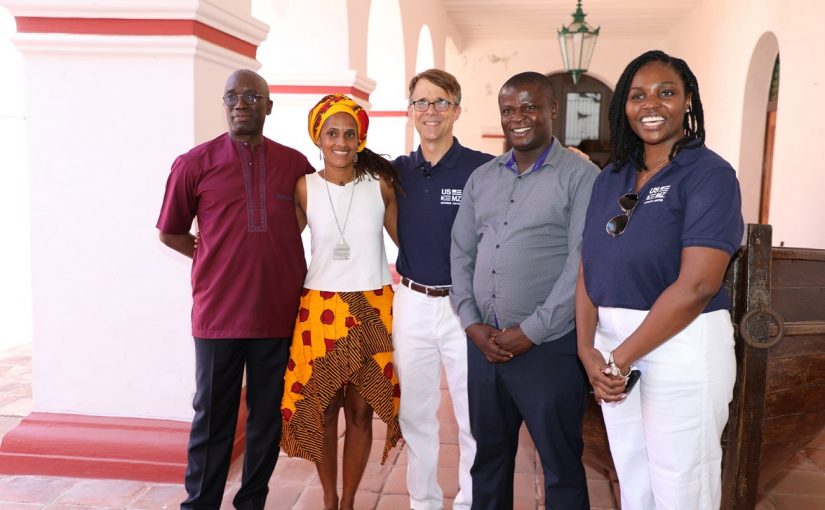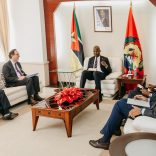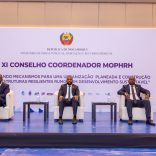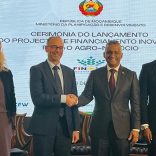Mozambique: Spanish Foundation stresses urgency of efforts to combat child mortality - Watch
Ambassador Vrooman officially launches the Sea Sound project to preserve and promote cultural heritage on Mozambique Island

UNESCO Director for Mozambique, Paul Gomis, Sea Sound Project from Sea Sound Project, U.S. Ambassador to Mozambique Peter H. Vrooman, Ilha de Moçambique's Director representative and U.S. Embassy Counsellor for Press and Culture, Vanessa Toscano.[Photo courtesy: US Embassy in Mozambique]
U.S. Ambassador to Mozambique, Peter H. Vrooman visited Ilha de Moçambique for the opening of the Sea Sound immersive exhibition “Nakhodha and the Mermaid”, dedicated to the preservation and promotion of the cultural, oral and artistic heritage of the fishing communities of the Island. Funded by the U.S. Ambassadors Fund for Cultural Preservation, the Sea Sound project is run by Fundação Fernando Leite Couto in partnership with YC Creative Platform. YC Creative Platform was founded by former Fulbright scholar and filmmaker Yara Costa Pereira, who directs the project. The Sea Sounds exhibition aims to preserve the cultural heritage of the coastal fishing community of Cabaceira Pequena and Ilha de Moçambique – a UNESCO World Heritage Site – which is adversely affected by climate change and under threat of losing its unique history due to the spread of violent extremism.
The U.S. Government provided $161,280 for this project, which can be used as a tool of community-based tourism and local resilience to climate change. “I am honored to be here and see the result of the collective effort of all those involved to preserve the cultural heritage of the fishing communities on the Ilha de Moçambique,” said Ambassador Vrooman. “The Ambassadors Fund for Cultural Preservation is contributing to the preservation and promotion of the local cultural heritage, which in turn will contribute to tourism and job creation on this beautiful island.” Ilha, a UNESCO World Heritage Site, has benefitted from past Ambassador’s Cultural Preservation Funds. Since 2016, the United States has invested more than $380,000 into the Slave Wrecks Project, which launched what has become a global efforts to excavate, study, and preserve artifacts from shipwreck sites carrying enslaved persons.
The Sea Sounds project included the work of six young community leaders and ten interns from UniLurio, who were trained in oral heritage research and recording, filming and editing techniques. An 8.5-meter dhow was built using the community’s ancestral traditions, which now serves to transport residents between Ilha de Moçambique and Cabaceira Pequena. The process of building the boat is part of more than 80 pieces of content on maritime cultural heritage and 120 songs by women and men from the sea, recorded in audio and video, which will soon be available on a digital platform and on community radio stations.
The three main components of the Sound of the Sea project under implementation include:
- Identifying and documenting traditional songs; sea chants; myths; tales; oral accounts of slavery; ancient boat-making and navigation techniques; through in-depth individual interviews, and sociological and anthropological analysis.
- Presenting this content in audio podcasts and visuals in a creative way to raise awareness of maritime heritage; using it to create a UNESCO sustainable tourism program and preserve this heritage for future generations around the world.
- The development of a digital maritime cultural heritage platform where one can listen to and view the 8-episode podcast on the maritime heritage of Mozambique Island and links to the African diaspora.
The content gathered in the Sea Sound project also gave birth to “Nakhodha and the Mermaid”, a groundbreaking 33-minute immersive mixed-media experience, which includes additional funding from the Sound Connects Fund, an initiative by the Music In Africa Foundation (MIAF) and Goethe-Institut, financed by the European Union with support of the Organization of ACP States. The exhibition takes the visitor on a sensorial and experiential journey, through a combination of spatial audio podcast, 360° video mapping images and virtual reality. The exhibition is available to tourists and residents of all ages.













Leave a Reply
Be the First to Comment!
You must be logged in to post a comment.
You must be logged in to post a comment.